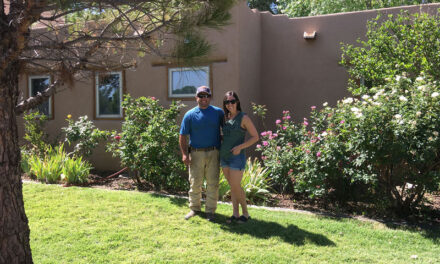Repairs are under way on the levees along the Rio Grande to prevent flooding.
Drew Baird, river analysis team leader for the Bureau of Reclamation, said levees from Velarde to the head waters of Caballo Dam below Elephant Butte need repairs.
“The issue is the banks of the river are eroding into the levees, the river is migrating into the levees. Part of it is natural river processes. Also, part is caused by a reduction in the amount of sand in the river.
“Rivers tend to be a lot straighter when there’s more sand, more sediment. There’s less sand now, so the river is migrating more. There’s less sediment coming in from the water sheds because of land use practices and climate conditions.”
When referring to the changes in land use practices, Baird said he meant there are fewer animals grazing on the water sheds now, affecting the water.
“The major reason is that most of the sediment is being stored in upstream reservoirs. When you build a dam, sediment settles in the reservoirs, and clear water is released from the reservoir.
“The banks of the river are migrating toward the levees and then the levee erodes away. This happens at what most people consider less-than-flood flows. The other part of it is part of a natural process. Rivers tend to migrate.”
Baird said that “in Belen, there are levees on both sides of the river. On the northwest side of Albuquerque, where the river is along the mesa, there’s no levy there, but, everywhere else, there’s continuous levees from Cochiti to Elephant Butte.
“In the last 70 or 80 years, the river has had so much sand coming in that the river is higher than the land beside the levee, which could lead to some low-level flooding,” Baird continued.
He could not say when or if levees in Valencia County would be repaired.
“There are levees on both sides of the river. Mostly, all throughout Valencia County are sand levees, not compacted levees (not engineered), so they are very erodable.”
However, he added, “most of the 25 priority sites (for repairs) are north of Albuquerque and south of San Acacia Diversion Dam.
“We are working vigorously on the eight highest priority sites, and work will continue on those for the next several years, rechanneling the river, protecting the banks with riprap.
“These are really low-level risks to the general public. Most of the areas where we have crews available do short-term emergency fixes and there’s really low-level flooding involved in any of these sites.”
Meanwhile, in Washington, D.C., U.S. Sen. Pete Domenici (R-N.M.) issued a press release expressing his concern about the condition of New Mexico’s levees.
Domenici met with John W. Keys, the commissioner of the Bureau of Reclamation, who discussed the work already begun on two critical sites north of Albuquerque.
Keys told Domenici that the Bureau does not expect a need for federal emergency funding to shore up the 25 weakened levees between Espanola and San Marcial, a news release said.
The Bureau has requested $15.4 million in fiscal year 2003 for the Middle Rio Grande Project, which includes the levee system on the river.
As part of the Energy and Water Development Appropria-tions Bill, Domenici last year secured $11.2 million for the Bureau of Reclamation to benefit species and water users along the middle Rio Grande.
Richard Jaramillo, Belen Division Manager of the Middle Rio Grande Conservancy District, said “the levees have deteriorated some. They may not be to their full capacity as they were designed because of time. For one thing, the river base has risen. As that rises, that decreases the area between the levee and the river.”
Jaramillo said he has noticed that, on NM 6, the river bottom has risen.
“On the north side of the bridge, cottonwoods are growing in the middle of the river. Silt has settled in the river, which has increased the height of the river. That could affect the levy. The river base varies, but the levees remain the same, but, because they remain the same and the river base is coming up, the amount of area between the bottom of the river and the top of the levee is decreasing, and this could cause a problem if there’s rain.”
















